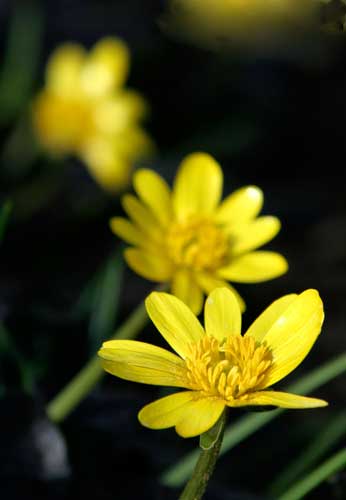
Pilewort is not the most flattering name for a plant, especially when its duty is to smile and shine bright as the nation's harbinger of spring. More curious still to learn that the knobbly, pile-like roots of this plant, more commonly known as Lesser Celandine (Ranunculus ficaria), were once used to treat haemorrhoids. It has had much to contend with and has been outlawed in parts of the USA where it was accidentally introduced and now threatens the native woodland flora. Internet forums deliberate mostly on the best way to get rid of it, rather than celebrate its significance in the gardening calendar, and most choose poison over digging, getting into quite a lather about the whole thing. But as a plant that provides an important source of nectar for emerging bees, and with no less than three poems written about it by William Wordsworth, there ought to be a measure of respect.
It's true that the Lesser Celandine has the ability to colonise where conditions (moist, light shade) resemble its woodland origins, but it's just as potent a portent as the primrose or aconite and, as a native, shouldn't be considered such a nuisance that eradication is the only course of action. I bought my first from John Carter of Rowden Gardens, probably the best-known exponent of the plant in the UK. He recently gave up his national collection to concentrate on water irises but will still find time to scour hedgerows for "Mother Nature's try-outs".
"Out of 150 or so variations of R. ficaria around 80 per cent have been collected from the wild," Carter explains. "The plant is unbelievably promiscuous so you can't rely on seed growing true to type." R. ficaria 'Brambling', not quite as dark as the chocolate-brown foliage of R. ficaria 'Brazen Hussy', is one he finds particularly alluring but he refuses to be drawn into a list of favourites as there's always something new just round the corner. "The permutations are infinite," he enthuses. "The surface of the petals comes in yellow, orange, white, cream and green; the colours of the reverse side include red, violet, blue, mahogany, grey and yellow; and then there's the foliage colour which differs from green to purple, with all the spotted, veined and tortoiseshell variations in between, a whole symphony of possibilities as the plant tries to better itself."
Seedlings of single flowering varieties are profuse, while doubles set very little seed; either way, the only reliable way of propagation is vegetative division. Some plants are more invasive than others but it's best to assume that the plant will get cheeky if left to its own devices. But this habit can be used to the gardener's advantage. With leaves appearing in January it can serve as useful ground cover under deciduous shrubs and among ephemerals such as bluebells, grape hyacinths and wild garlic. Blooming from March to May and shy of low light, the clear yellow flowers with eight to 12 petals open in sunlight above glossy dark green, heart-shaped leaves that melt away completely come June. They therefore work well among hostas and ferns where stronger foliage obscures any bare patches once the buttercup outrider has gone to ground.
Shady urban spaces often offer woodland-like conditions, so it's not completely unreasonable to ask this charming plant to bring early cheer to our backyards. Some say that the leaves, if picked before the flowers emerge, make a tasty addition to salad and that flower buds are a good substitute for capers. Considering that the plant is known to be toxic and that it was once common practice for beggars to rub parts of the plant on to their skin to induce sores, I can't bring myself to champion its culinary delights without trying it myself. At the time of writing, the leaves of the Pilewort are yet to emerge in my own garden. What a shame. Another time perhaps?
Subscribe to Independent Premium to bookmark this article
Want to bookmark your favourite articles and stories to read or reference later? Start your Independent Premium subscription today.

Join our commenting forum
Join thought-provoking conversations, follow other Independent readers and see their replies